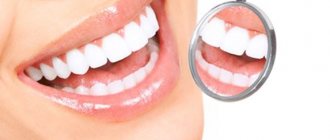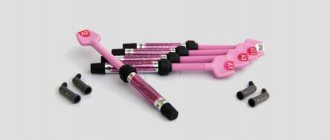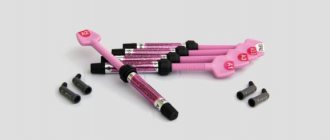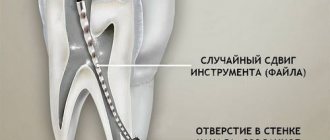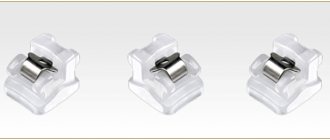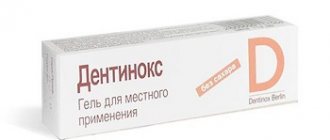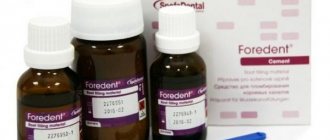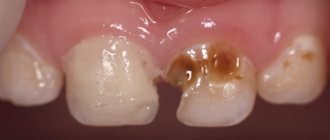Thanks to modern technology, visiting the dentist has become a simple and painless procedure that allows you to monitor your oral health and identify and eliminate various problems. The best material used for filling teeth today is Estelite - a composition that has no analogues in terms of durability, ease of use and reliability.
Characteristics and properties
Estelite (Estelite Sigma Quick) is a development from Japan, created and used for dental filling. High indicators of light curing, radiopacity and polymerization speed guarantee the appropriate quality of the finished fillings.
The composition is based on silicon-zirconium mass, the total share of which exceeds 80%. Its use is the key to minimal shrinkage of the processed material, resistance to wear and abrasion. The color range, numbering two dozen shades, and the long-term preservation of aesthetic properties maintained by polishing allow Estelite to be effectively used in various medical situations.
Indications Estelite
- Direct restoration of anterior and posterior teeth, including the occlusal surface of teeth and carious cavities of all classes;
- Dental restoration with direct composite veneers;
- Diastema closure;
- Restoration of ceramic and composite restorations.
Contraindications Contains methacrylic monomers. Estelite is CONTRAINDICATED in patients who are allergic or hypersensitive to methacrylic and similar monomers.
Precautionary measures
1) DO NOT USE Estelite for purposes not provided for in these instructions. Use strictly in accordance with the recommendations given here.
2) Estelite Sigma Quick is intended for sale and use only by licensed dental practitioners. This material is not intended for use by persons other than dental professionals.
3) DO NOT USE if security seals on packaging are damaged or there is any doubt about their authenticity.
4) If Estelite causes an allergic reaction or hypersensitivity in the patient, you should immediately stop using the drug.
5) To avoid an allergic reaction to methacrylic monomers, it is recommended to use examination gloves (polymer, vinyl or latex) at all stages of working with Estelite Sigma Quick.
Note: Some substances/materials may penetrate examination gloves. If Estelite comes into contact with examination gloves, immediately remove them and wash your hands thoroughly with water.
6) Do not allow Estelite Sigma Quick to get into your eyes, mucous membranes, skin or clothing.
- In case of contact with eyes, rinse immediately with plenty of water and consult an ophthalmologist.
- If Estelite gets on the mucous membrane, immediately wipe the affected area and then rinse thoroughly with plenty of water.
- If Estelite Sigma Quick gets on your skin or clothing, immediately clean the affected area with a cotton or gauze swab soaked in ethyl alcohol.
- The patient should rinse his mouth immediately after treatment.
7) Estelite should not be swallowed or inhaled. Swallowing or inhaling the material may cause serious injury.
8.) To avoid ingesting the drug by mistake, keep it out of the reach of children and patients.
9) Clean filling instruments with alcohol after use.
10) When using the photopolymerizer, you should wear safety glasses.
Features of application
During use of the composition, the monomer is filled to 100%, forming a solid structure. Simultaneous filling of dentin fragments promotes uniform demineralization and penetration of adhesive elements inside. The composition is characterized by stable adhesive strength indicators, which are not affected by the quality of the working area.
To determine the filling boundary, dentists rely on the colored pigment, which subsequently disappears from the surface of the tooth. After polymerization, the composition reduces the permeability and sensitivity of the enamel.
Dental filling: what is it in dentistry and what does it look like, types of dental filling
Even small children know what a filling is. Filling material is used to fill cavities caused by treatment of carious lesions or trauma. If you know the type of filling material that can closely mimic healthy tissue, you can choose fillings that will last for many years.
The installation process is quite complicated and requires professionalism and accuracy from the doctor. All manipulations can become useless if any of the steps are performed incorrectly.
What is a filling?
Millions of people get rid of carious lesions without removing teeth, thanks to medicinal ointments used in dentistry. It contains various chemicals with their own characteristics, advantages and disadvantages. The main goal of treatment is to restore the integrity of the dental block, restore full chewing function and prevent the penetration of pathogenic microorganisms into damaged tissues.
Inserting tabs is not always practical. Extensive damage requires longer and more labor-intensive reconstruction with bridges or implants.
Temporary and permanent fillings
They are divided into these types depending on their purpose. The first type (diagnostic) is used to isolate the unit for some time; a drug with medicinal additives is applied in advance under the filling material.
The doctor also decides to place the device if it is suspected that the patient may have pulpitis. The filling is made of low-strength compounds that do not have a long service life. Thanks to this property, the dentist can easily remove the filling material from the cavity. In most cases, synthetic dentin is used in the manufacturing process. When drilled with a drill, it helps close the cavities into which arsenic is placed to kill the nerves.
Permanent elements are more difficult and take longer to put on. They must last long enough, so they are made from durable and wear-resistant mixtures. Installation consists of several sequential steps that should not be skipped. Sealing material helps ensure
Indications for use, preparation and application
The universal characteristics of high-quality fillings formed using Estelite provide a wide range of possibilities for use. Possible clinical indications include:
- restoration of the frontal jaw area;
- correction of surface defects on enamel;
- direct restoration of the base layer;
- restoration of installed prostheses;
- elimination of gap-like spaces and diastemas;
- therapeutic prevention of caries.
The presence of methacrylic-based monomers in the composition of the drug is a key factor limiting the possibility of use for people suffering from allergic reactions to compounds of this group. Intolerance to this element should be clarified before starting therapy.
When preparing the oral cavity for medical restoration, a number of procedures are performed in the required sequence:
- Cleaning the enamel layer using a special mass that does not contain fluoride;
- Selecting a color tone using a shade scale;
- Isolation of the dentition element using latex plates;
- Standard preparation followed by rinsing with water;
- Pulp protection with an artificial glass ionomer barrier;
- Application of the composition and formation of the restoration contour.
During the restoration process using Estelite, it is recommended to strictly follow the instructions for use. The composition is applied either directly into the working cavity of the tooth, or squeezed out of a syringe onto a separate tablet to give the desired consistency. The introduction into the hole is carried out layer by layer, without exceeding the depth, and each layer must undergo a polymerization procedure, the duration of which is determined by the manufacturer’s special table. It is important to note that mixing the composition with other restorative pastes leads to the formation of voids and defects in the final polymerization.
At the final stage, the finished filling is processed and polished using a fine-grained drill. To improve the aesthetic perception and appearance, fractional grinding technology is used at minimum speed, without the use of water. Proximal elements should be treated with vinyl or metal strips. The finished shape can be further polished using a special rubber nozzle or other device.
Estelite instructions
1) Cleaning Thoroughly clean the tooth surface with a rubber cup containing fluoride-free paste, and then rinse with water.
2) Shade selection Before installing the rubber dam, select the appropriate shade using the Estelite Sigma Quick shade guide.
- The shade must be selected within 5 minutes; Dry teeth are lighter than moistened teeth.
- White saturation (color intensity) is the most important factor in choosing a shade.
- If you're debating between two shades, choose the lighter shade (the shade that has the most color intensity).
- When working with whitened teeth, shade selection should be done a few weeks after the whitening procedure. Whitened teeth may darken slightly.
3) Isolation Rubber dam is the best method for isolating a tooth.
4) Preparing the cavity Prepare the cavity and rinse thoroughly with water. Bevel the edges of the enamel when preparing anterior teeth (Class III, IV, V) and smooth the edges of the enamel when preparing posterior teeth (Class I, II). Bevels and smoothing of the enamel edges ensure that the boundary between the cavity edge and the restoration disappears, improving aesthetics and retention.
- From the point of view of aesthetics and strength, scalloped bevels (undulant, scalloped bevel) are preferable.
- When restoring ceramic or composite restorations, roughen the surface with a diamond bur to improve adhesion; for cleaning purposes, etch the tooth surface with phosphoric acid; rinse thoroughly with water; dry the tooth surface and apply silane according to the manufacturer's instructions.
5) Pulp protection If the cavity is located in close proximity to the pulp, a glass ionomer or calcium hydroxide gasket should be applied. To protect the pulp, DO NOT USE EUGENOL-BASED MATERIALS, as they inhibit the polymerization of the bond and/or Estelite.
6) Adhesive System Apply light-curing adhesive system according to the manufacturer's instructions. We recommend using TOKUYAMA BOND FORCE, which is a one-part, self-etching, light-curing dental adhesive.
— Self-curing adhesive systems should not be used. With Estelite we recommend the use of light-curing adhesive systems, since other types of adhesive systems, such as, for example, self-curing adhesive systems or dual-curing systems, will not provide effective adhesion when using light-curing composite materials. If you do use self-curing or dual-cure adhesive systems, make sure they can be used with light-curing composite materials.
7) Dosing 7-1. Unidose (PLT) Before use, carefully read the Special Instructions for Use of Unidose.
- Place the PLT in a suitable dispenser.
- Remove the PLT cap.
- Apply the paste directly into the cavity or pre-squeeze it onto the mixing pad.
7-2. Syringe Remove the cap of the syringe. Turn the handle clockwise to squeeze out the paste onto the mixing plate. Immediately after this, put the cap on the syringe. - DO NOT apply excessive force to the syringe if it has just been removed from the refrigerator.
8.) Filling and contouring of the restoration Bring the material into the cavity in layers. The layer of material should not exceed the specified depth (check the table above). - DO NOT mix Estelite with other types of composite materials or other shades of Estelite Sigma Quick to avoid incomplete polymerization or the formation of voids.
9) Curing Cure each layer for at least the recommended time (check table above), keeping the curing machine 2mm away from the material. — When using other brands of composite materials in layers with cured composite, follow the instructions for using those materials.
10) Finishing Process and polish the restoration. For finishing, use fine-grit diamond burs. To reduce the interface between the composite material and the natural tooth, work along the interface with a 12-point carbide bur, without water and at low speed. Use metal or vinyl sanding strips for proximal surfaces. For polishing, use rubber heads or any other suitable polishing tools such as PoGoTM (DENTSPLY/Caulk), Sof-Lex (3M ESPE), Identoflex HiLuster Dia Polishers (Kerr), or D-FINETM Hybrid Diamond.
